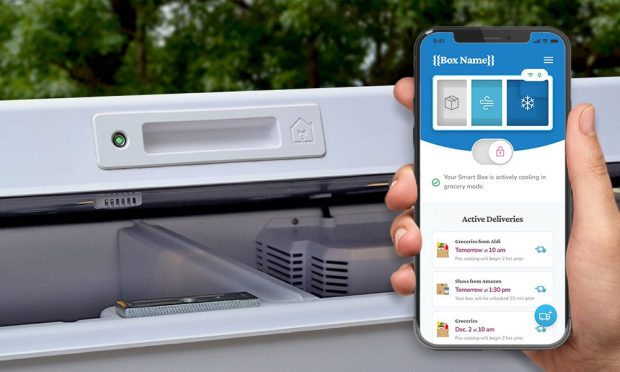Walmart Leverages Alternative Fulfillment Methods to Drive Delivery Sales With Away-From-Home Consumers

While grocery delivery orders soared during the early months of the pandemic as consumers sought stay-at-home alternatives to their usual habits, 2021 revealed the limitations of the channel for consumers who wanted the convenience but could not always be counted on to be at home.
Now, grocers are rolling out alternatives to retain their delivery customers even as consumer mobility varies. Amazon, for instance, offers delivery right into consumers’ garages, while Ahold Delhaize-owned FreshDirect offers office grocery delivery.
After announcing an expansion to its in-fridge delivery program in early January, leading grocer Walmart shared the following week that it is partnering with solution provider HomeValet to drop off grocery orders at any time of day to temperature-controlled “smart boxes” outside consumers’ homes.
Read more: Walmart to Offer In-Fridge Grocery Delivery to 30M Homes; But Do People Want It?
See also: Walmart Partners With HomeValet on Smart Box Technology for Fresh Deliveries
“Our calculus is, if we can solve the problems at the home for the consumer, we can attack a lot of the other issues that cause extra cost or inconvenience in the marketplace of home delivery,” HomeValet Co-Founder and Chief Operating Officer Jack Simms told PYMNTS in an interview. “For grocery specifically, it’s issues of scheduling. Coordination with the consumer costs an enormous amount of money… Our goal is to eliminate the need for retailers to coordinate with consumers at all.”
The ability to make deliveries work could go a long way toward attracting customers and driving order frequency. According to PYMNTS’ research from the new study “Decoding Consumer Loyalty: The Customer Loyalty To Merchants Survey 2022,” created in collaboration with Toshiba Global Commerce Solutions, one in five shoppers said the ability to have products delivered would improve their loyalty to their grocery store.
Get the study: The Customer Loyalty To Merchants Survey 2022
Certainly, this preference is reflected in the data concerning stores consumers are actually shopping at, with 28% of consumers having shopped at Walmart, which offers a wide range of delivery options, in the previous thirty days, making it the most frequented brand by a significant margin, well ahead of runner-up Kroger’s 9%.
A Foot in the Door
Simms noted that the “novelty of the product” could be the largest hurdle to adoption, as consumers will need to purchase an entirely new appliance. However, once the box is in the homes, HomeValet will have insight into a range of information about how consumers interact with their online grocery orders at their homes, such as how often and what times of day they typically collect their items.
“There’s a lot of opportunity for home valet to provide exceptional experiences to our consumers through understanding their purchase and delivery behavior, and that’s something that we’re going to be exploring in the future, with consumer privacy as our No. 1 priority,” said Simms.
The Endurance of Bring-It-to-Me Expectations
Simms predicted that, as consumers grow increasingly accustomed to a range of digital options, delivery will be just one piece of the eGrocery puzzle in years to come.
“I think that there’s a multiplicity of solutions that are not only viable but highly adaptable in the market by the average consumer, and I think a lot of consumers will find that they enjoy using a mix of these solutions — that sometimes delivery is great, and sometimes you just want to drop by the store and pick it up on the way home,” he said.
He noted that, although adoption of grocery delivery has normalized somewhat since 2020, it remains elevated, and he said he sees “an upward trend generally.” Sure enough, PYMNTS research from 2020’s Omnichannel Grocery Report, created in collaboration with ACI Worldwide, found that 42% of consumers report buying online and having the products delivered home.
See more: What US Consumers Want Grocery Stores to Know About How They Want to Shop And Pay
Then, in PYMNTS’ 2021 study, “What Consumers Expect From Their Grocery Shopping Experiences,” another ACI collaboration, just 23% reported buying grocery products online and having them delivered to their homes.
Read more: New Study Finds Grocery Shoppers Favoring Physical Stores and Digital Payments
Still, industry insiders — both those who stand to profit from the growth of grocery delivery and those with no proverbial horse in this race — are fairly unanimous in predicting that the market will only continue to grow in years to come.
The Ghost Kitchen-ification of Grocery
As this more digital future comes into view, Simms said he expects that more of the grocery process will be automated, with data-informed auto-replenishment completely removing the work of purchasing everyday necessities.
Additionally, he said he predicts that grocery retailers may take a tip from digital newcomers and from the restaurant industry’s ghost kitchens and go fully online.
“You might even see the complete virtualization of some brands,” he said. “It’s not outside of the realm of reality to think that some brands may find it advantageous not to have brickand m-ortar at all anymore, and to focus entirely on a digital shopping and logistics experience, so I think there’s a lot of transformation about to happen.”
